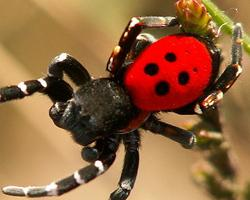
Súlyok és méretek
| Hossz | 10-tól 14-ig mm |
|---|
Veszélyeztetettség
| Veszélyeztetett |
Állatleírás
The Ladybird spider, scientifically known as Eresus kollari, is a fascinating and visually striking species belonging to the Eresidae family. This small yet captivating spider is renowned for its vibrant coloration and unique appearance, which draws the interest of both arachnologists and nature enthusiasts alike.Adult male Ladybird spiders are particularly noted for their striking color pattern. They possess a vivid red or orange abdomen adorned with several large, black spots, reminiscent of the common ladybird beetle, which is how they derive their common name. This bright coloration not only makes them stand out in their natural habitat but also serves as a warning to potential predators about their venomous nature. The rest of the male's body is predominantly black, including its cephalothorax (the fused head and thorax) and legs, which are covered in fine hairs.
In contrast, female Ladybird spiders exhibit a more subdued color palette. They are larger than males and have a velvety black appearance, with their bodies covered in dense, dark hairs. Unlike the males, females spend most of their lives in underground burrows, emerging primarily to capture prey or during the breeding season.
Eresus kollari is found in various parts of Europe, with populations recorded from Spain in the west to Ukraine in the east. Their preferred habitats are warm, sandy areas where they can easily dig their burrows, such as heathlands, sand dunes, and light forests. These spiders are sedentary creatures, rarely venturing far from their burrows, which they line with silk to form a smooth tunnel that ends in a chamber. This chamber serves as a retreat and a place to store food and lay eggs.
The diet of the Ladybird spider primarily consists of small insects and other arthropods. They are ambush predators, waiting at the entrance of their burrow for unsuspecting prey to pass by before quickly capturing them with their powerful venom and sharp fangs.
Reproduction in Eresus kollari is a perilous time for males. After reaching maturity, males leave their burrows in search of females, which can often be a dangerous journey, exposing them to predators. Once a male finds a female's burrow, he must perform a delicate courtship dance to avoid being mistaken for prey. If successful, the female will allow him to mate. Unfortunately, males typically die soon after mating, either naturally or as a result of being consumed by the female.
Ladybird spiders lay their eggs in silk cocoons within their burrows. The spiderlings are cannibalistic, often eating their siblings for survival. The few that do survive eventually leave the burrow to fend for themselves.
Despite their fascinating biology and behavior, Ladybird spiders have faced significant threats from habitat destruction and collection for the pet trade. Conservation efforts in some countries have been implemented to protect these unique creatures and their habitats, aiming to ensure that the Ladybird spider continues to be a part of our natural world for generations to come.
Hasonló állatok
Új állatfotók
Top 10 állat
- Dolphin gull (Leucophaeus scoresbii)
- Diana monkey (Cercopithecus diana)
- Moustached guenon (Cercopithecus cephus)
- Galápagos tortoise (Geochelone nigra complex)
- Japanese macaque (Macaca fuscata)
- Stone loach (Barbatula barbatula)
- Russian tortoise (Testudo horsfieldii)
- Greek tortoise (Testudo graeca)
- Common flying dragon (Draco volans)
- Vendace (Coregonus albula)
